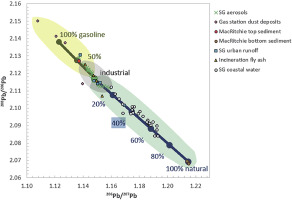Environmental Pollution ( IF 8.9 ) Pub Date : 2017-10-27 , DOI: 10.1016/j.envpol.2017.09.025 Gonzalo Carrasco , Mengli Chen , Edward A. Boyle , Jani Tanzil , Kuanbo Zhou , Nathalie F. Goodkin

|
Pb is a trace metal that tracks anthropogenic pollution in natural environments. Despite recent leaded petrol phase out around Southeast Asia, the region's growth has resulted in continued exposure of Pb from a variety of sources. In this study, sources of Pb into Singapore, a highly urbanised city-state situated in the central axis of Southeast Asia, are investigated using isotopic ratios and concentrations. We compiled data from our previous analyses of aerosols, incineration fly ash and sediments, with new data from analyses of soil from gas stations, water from runoff and round-island coastal seawater to obtain a spatio-temporal overview of sources of Pb into the Singapore environment. Using 206Pb/207Pb ratio, we identified three main Pb source origins: natural Pb (1.215 ± 0.001), historic/remnant leaded petrol (1.123 ± 0.013), and present-day industrial and incinerated waste (1.148 ± 0.005). Deep reservoir sediments bore larger traces of Pb from leaded petrol, but present-day runoff waters and coastal seawater were a mix of industrial and natural sources with somewhat variable concentrations. We found temporal variability in Pb isotopic ratio in aerosols indicating alternating transboundary Pb sources to Singapore that correspond to seasonal changes in monsoon winds. By contrast, seasonal monsoon circulation did not significantly influence isotopic ratios of coastal seawater Pb. Instead, seawater Pb was driven more by location differences, suggesting stronger local-scale drivers of Pb such as point sources, water flushing, and isotope exchange. The combination of multiple historic and current sources of Pb shown in this study highlights the need for continued monitoring of Pb in Southeast Asia, especially in light of emerging industries and potential large sources of Pb such as coal combustion.
中文翻译:

后铅汽油新加坡环境中铅同位素清单的更新
铅是一种痕量金属,可追踪自然环境中的人为污染。尽管最近在东南亚逐步淘汰了铅汽油,但该地区的增长导致各种来源的铅持续暴露。在这项研究中,使用同位素比率和浓度研究了进入东南亚中部高度城市化城市新加坡的铅的来源。我们汇总了之前对气溶胶,焚烧粉煤灰和沉积物的分析数据,以及对加油站土壤,径流水和圆岛沿海海水进行分析的新数据,以获得时空变化的新加坡铅来源的时空概况。环境。使用206 Pb / 207铅的比例,我们确定了三个主要的铅来源:天然铅(1.215±0.001),历史/残余铅汽油(1.123±0.013)和当今的工业和焚化废物(1.148±0.005)。深层水库沉积物中含有更多的含铅汽油中的Pb痕迹,但是当今的径流水和沿海海水是工业和自然资源的混合,其浓度有所不同。我们发现气溶胶中铅同位素比值随时间变化,这表明交替的跨境铅源流向新加坡,这与季风的季节变化相对应。相比之下,季节性季风环流并没有显着影响沿海海水Pb的同位素比。取而代之的是,海水Pb受位置差异的驱动更大,这表明Pb在当地的影响更大,例如点源,冲水,和同位素交换。这项研究显示了多种历史和当前的铅来源的结合,突显了需要对东南亚的铅进行持续监测,特别是考虑到新兴行业和潜在的大量铅来源,例如煤炭燃烧。



























 京公网安备 11010802027423号
京公网安备 11010802027423号